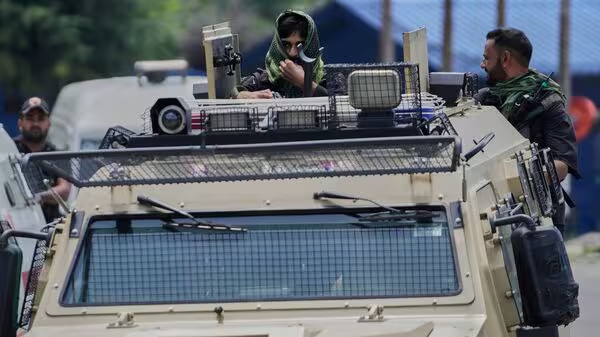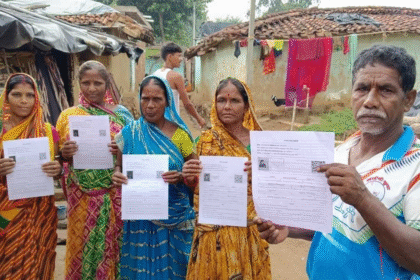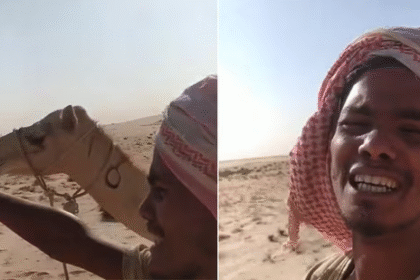Pahalgam Terror Attack Mastermind Suleman Shah Killed in Intense Firefight with Security Forces
A Morning That Started With a Name
In the stillness of an early July morning, long before the sun broke over the Pir Panjal mountains, a single name echoed through the intelligence corridors of India’s counter-terror command: Suleman Shah.
To most, the name meant little. But for those tracking Kashmir’s undercurrent of cross-border militancy, Suleman Shah wasn’t just a person—he was a code, a ghost, a mission.
Suspected to be the mastermind behind the deadly Pahalgam terror attack that had claimed the lives of multiple civilians and security personnel months earlier, Shah had been on the radar of Indian intelligence for nearly two years. He was said to be a commander of the Pakistan-backed terror outfit Lashkar-e-Taiba (LeT), responsible for planning, coordinating, and supervising attacks deep inside Indian territory, especially targeting tourist-heavy zones to destabilize the region’s economic return to normalcy.
The Pahalgam Attack: A Scar in the Valley
The Pahalgam attack, carried out earlier in 2025, wasn’t just another militant ambush. It was symbolically targeted. Pahalgam—known for its breathtaking alpine beauty, pilgrimage routes, and tourist economy—was supposed to represent the promise of normalcy in post-370 Kashmir. When gunmen opened fire on a convoy that included tourists, pilgrims, and local transporters, the intent was clear: to send a chilling reminder that peace in Kashmir remains fragile.
The attack left 8 dead and 14 injured, including children and elderly civilians. It shocked the nation, ignited outrage, and became a turning point in how future threats would be addressed. The security forces vowed swift justice. And at the heart of that promise lay one name: Suleman Shah.
Months of Silence, Followed by a Whisper
In the weeks following the Pahalgam massacre, security agencies launched a region-wide manhunt. Drones buzzed above southern Kashmir. Raids intensified. Villages were searched, informants mobilized. But Shah had vanished.
He was believed to have crossed back into the woods of south Kashmir, hiding in the dense forest belt between Tral and Anantnag, frequently changing locations, protected by a trusted network of overground workers (OGWs) and possibly aided by sympathetic local guides.
Then, suddenly, last week—a whisper.
An intercepted message between two low-level LeT operatives mentioned a “senior commander moving towards Lidroo sector”, a region that links several infiltration trails and connects to Pahalgam’s outer forests. Surveillance immediately intensified.
The Build-Up: Tension Behind the Trees
The intelligence agencies, working in close coordination with the Jammu and Kashmir Police, Indian Army’s 19 Rashtriya Rifles, and CRPF Quick Reaction Teams, pieced together a plan that had been long in the making.
This time, it wasn’t about chasing shadows. This was a surgical objective—track, isolate, and eliminate. Teams began to close in on a suspected safehouse deep in the upper reaches of the forested Lidroo area, where Shah was believed to be holed up along with two or three close aides.
The operation was kept completely confidential. There were no public alerts, no visible build-up. Even within the force, only a handful of top-level commanders were looped in. The goal was simple: avoid public panic, eliminate the threat with zero civilian engagement.
The Encounter: Silence Turns into Fire
On July 27, as first light broke over the valley, security forces surrounded the suspected hideout. The house—a modest stone structure built into the mountain slope—appeared empty at first. But thermal scans from an aerial drone revealed movement. At least three armed individuals were inside.
At exactly 5:34 AM, the first warning call was issued. Using a loudspeaker, security personnel demanded surrender. The response? Gunfire—sustained and heavy, followed by the sound of grenades being thrown from inside the house.
The intensity of the firefight surprised even seasoned soldiers. Suleman Shah and his associates weren’t just hiding—they were prepared, entrenched, and determined to go down fighting. Automatic gunfire echoed across the valley, loud enough to be heard in the distant town of Anantnag.
The security forces withdrew slightly, adopted elevated positions, and initiated a tactical siege. The battle was not going to be quick. Shah was armed, experienced, and desperate.
A War of Nerves and Firepower
The encounter lasted over six hours. Snipers were deployed. UAVs hovered overhead. Trained dogs were brought in to detect any hidden exits or tunnels. Communication intercepts suggested that Shah was in constant touch with handlers across the border—perhaps sending real-time updates before the final moments of his life.
By mid-day, one militant tried to escape through a rear exit. He was quickly gunned down. It wasn’t Suleman.
Then, around 12:46 PM, a final exchange of fire ended with the collapse of part of the structure. When the debris cleared, three bodies were recovered—two confirmed aides and, finally, Suleman Shah.
Confirmation came through facial recognition software, corroborated by human intelligence and documents recovered on-site.
Aftermath: A Message Delivered
By evening, the news had reached Delhi: “Target neutralized. Suleman Shah killed.”
For the forces involved, it was a moment of closure—but not celebration. A top officer from the operation team simply stated:
“We don’t celebrate deaths. But we do believe in closure. This was justice, not vengeance.”
The body was not paraded. No pictures were leaked. The message was sent not through visuals, but through the precision of the operation itself—India had not forgotten Pahalgam. And it had not forgiven.
A Boy from the Valley, Not Born with a Gun
To understand the rise—and eventual fall—of Suleman Shah, one must step back from the headlines and enter the long shadows of a wounded land. Born in Pulwama district, sometime in the late 1990s, Suleman was not always the figure of terror he came to symbolize in later years.
Locals who knew him in his early teens described a quiet, observant child, more interested in cricket than conflict, more drawn to poetry than politics. His father worked in a modest apple orchard. His mother, a homemaker. His schooling was patchy, interrupted more by family hardships than ideology.
But what changed a boy into a militant commander? What snapped?
The answer lies not in one event, but in a sequence of fractures—personal, political, and psychological.
The Tipping Point: From Disillusion to Doctrine
In 2016, Kashmir was set ablaze by the killing of Burhan Wani, a young Hizbul Mujahideen commander whose death triggered mass protests across the Valley. For many young Kashmiris, it wasn’t just about militancy—it was about identity, alienation, and powerlessness.
Suleman was 17 then. That year, he disappeared for the first time—gone from his home for nearly three weeks. When he returned, he was changed. According to neighbors, he began attending underground gatherings, stopped interacting with former friends, and became increasingly hostile toward mainstream narratives.
By 2018, Suleman had formally joined Lashkar-e-Taiba, operating initially as a courier and message-carrier between Tral and Anantnag. His climb was swift. Not because he was the most educated or trained, but because he knew the terrain, trusted no one, and obeyed orders without question.
Within two years, he had earned a new identity: “Abu Talha”, a codename that became feared across the southern sector.
Radicalization: The New Age Blueprint
Suleman’s transformation wasn’t accidental. He was part of a new wave of radicalization—less religious, more political; less driven by scripture, more by vengeance and victimhood.
LeT’s propaganda arm had begun using social media cells, encrypted messengers, and online radical forums to target young Kashmiris. It was no longer about sermons in mosques or recruitment from across the border. The battle had shifted to Telegram, WhatsApp, Instagram—and more dangerously, into private chat rooms camouflaged as study groups.
Suleman was a product of this virtual machine—fed videos of clashes, doctored footage, and emotional testimonies from across Palestine, Afghanistan, and Syria. It created an echo chamber where the line between injustice and justification blurred.
He wasn’t just trained to fire a gun. He was trained to believe that every bullet was an act of justice.
His Role in Lashkar’s Structure
By 2021, Suleman Shah had been assigned the role of Area Commander for Anantnag and Pahalgam by his Pakistani handlers. This made him responsible not only for attacks but also for fund disbursal, ideological vetting, and training of new recruits.
His network was decentralized—designed to survive even if one limb was cut off. He worked with a group of Overground Workers (OGWs)—civilians who offered shelter, food, or transport in exchange for cash or safety. Some were ideologically motivated; others, coerced.
Security officials say that he never stayed in one location for more than 48 hours, often using shepherd trails, forest tunnels, and abandoned homes to evade detection. His most dangerous asset was not just his weapon—it was his invisibility.
The Making of the Pahalgam Attack
The Pahalgam attack, masterminded by Suleman, was deliberately planned to coincide with the early tourist season. Intelligence later confirmed that Suleman had chosen the convoy route specifically because it included pilgrims, tourists, and CRPF protection units—a mix that would create national outrage and international headlines.
He had spent weeks scouting the road, mapping the routine timings, and planting explosives with the help of two teenage recruits. The day of the attack, he reportedly monitored the assault from a nearby ridge, directing movement via radio.
After the blast and gunfire, he vanished into the woods before security forces could even establish a response perimeter.
The aftermath was catastrophic—not just in terms of death and injury, but in how it fractured the sense of safety that the Valley was slowly reclaiming.
The Mental Toll of Becoming a Target
By the time Suleman’s name appeared on the “Most Wanted” list, he had already become a ghost. But with that notoriety came a psychological weight. Multiple intercepted calls and testimonies from captured associates suggested that Suleman suffered from severe paranoia in his final months.
He trusted no one, even within his own module. He frequently changed devices, burned SIM cards, and refused to sleep in enclosed spaces. His communications had grown erratic. Some nights, he would talk to himself, convinced drones were flying overhead even when none were present.
This mental deterioration, ironically, made him more dangerous. He had become a man with nothing to lose.
A Symbol, Broken
For years, Suleman Shah had been a poster boy for Lashkar’s Kashmir operations—a symbol of elusiveness, resilience, and local leadership. His name was whispered in rural villages as both fear and legend.
But by 2025, that image was unraveling. Most of his early aides had been killed or captured. His network had shrunk. And newer recruits saw him not as a hero—but as a relic of a dying ideology.
His death was inevitable. The only question was when.
Anatomy of a Fall
The journey of Suleman Shah—once a young boy from Pulwama, later a feared terrorist, and finally a man isolated in the woods—reflects a broader truth about the militancy crisis in Kashmir. That it feeds on vulnerability. That it evolves. And that it ends—sooner or later—in blood, silence, and regret.
His end was not a victory cry. It was a quiet warning—that the next Suleman could be just a boy on a smartphone, watching, waiting, and one algorithm away from the same path.
The Forest That Became a Battlefield
On a rugged slope outside the Lidroo forest sector, about 8 kilometers from the famed tourist base of Pahalgam, a landscape of dense pine, silence, and breeze was shattered by what residents now call “six hours of thunder.” The trees still stand, but some of them bear fresh bullet scars. The once-unmarked house where Suleman Shah was killed now lies in rubble, half-burned and blown open by controlled charges.
It’s here that three lives ended, a command network collapsed, and Kashmir witnessed another chapter of the long war between insurgency and national order.
But what happened in those hours wasn’t just a military operation. It was an experience etched into the memory of an entire hamlet—where gunfire shook windowpanes, families hid behind wooden cupboards, and the sky buzzed with drones.
The Local Residents: Caught in the Crosshairs
In the village adjacent to the encounter zone, most of the residents had gone about their usual early morning chores—feeding cattle, fetching water, walking children to the local madrassa. No one suspected that an elite multi-agency team had already surrounded the forest edge, tightening its perimeter around a known threat.
But at 5:30 AM, when the first burst of gunfire echoed down the valley, panic set in.
“My hands were inside the tandoor oven when I heard the first shot. I thought it was thunder,” said Zahira Bano, a 42-year-old homemaker. “Then it kept coming. And louder. I grabbed my children and ran inside. We stayed under a bed for over three hours.”
Many villagers echoed similar stories. Some recalled seeing flashes of red lights from drones in the early morning sky. Others said they were told to remain indoors by local police who quickly spread the word through door-to-door alerts rather than public announcements, keeping panic levels down.
The entire village was under de facto lockdown—phones down, roads closed, fields inaccessible.
“We’re used to checkpoints and searches,” said Imran Wani, a shopkeeper. “But this was different. This was war in our backyard. And none of us asked for it.”
After the Smoke Cleared: What Was Found
At around 1 PM, once the area had been declared secure, the recovery team moved in. The three bodies—charred, riddled with shrapnel and gunfire—were pulled from the remains of the house.
In addition to Suleman Shah’s identity documents, a Chinese-made automatic rifle, multiple magazines, two mobile phones, and a sophisticated encrypted communication module were recovered.
What shocked the investigators wasn’t just the weaponry, but the volume of planning material. Maps of southern Kashmir districts. Marked patrol routes. Satellite printouts. And a flash drive containing what appeared to be recruitment propaganda videos—possibly meant for local distribution via Bluetooth or offline file sharing.
“He wasn’t just fighting. He was building something—an ideological mini-lab meant to outlive him,” noted one intelligence officer.
Human Cost: The Invisible Wounds of Constant Conflict
What happened that day in Lidroo was, in operational terms, a success. But for the people on the ground, it was a traumatic reminder that conflict in Kashmir is never truly over—just hidden, waiting.
Children like 11-year-old Ayaan Mir now wake up at night, mimicking gunfire sounds. Elderly residents still flinch when a vehicle backfires. Mental health experts, many of whom have worked in conflict zones globally, emphasize that prolonged exposure to militarized environments creates deep psychological fissures, especially among youth.
“When conflict becomes normalized, so does numbness,” says Dr. Samira Kaul, a psychiatrist in Srinagar. “The children of Lidroo may not cry today. But years later, those sounds, that fear, those broken routines—they will echo in their memories.”
Some families are even considering leaving the area permanently, citing growing anxiety and unpredictability.
“We just want to raise our children in peace,” says Maqbool Lone, a local farmer. “We don’t care who was killed. We only care about surviving the next time.”
Burial Without Mourning: How Militants Are Handled
After identification, Suleman Shah’s body—along with those of his two aides—was not returned to his family. Following existing J&K protocols introduced after 2020, militants are buried in remote locations under strict state supervision to avoid public gatherings or potential glorification.
The burial took place late at night in a restricted area, attended only by police personnel, a local magistrate, and medical officers who conducted DNA sample verification.
This policy has remained controversial, with human rights advocates arguing it denies basic dignity. However, law enforcement insists it is necessary to prevent funeral processions from becoming militant propaganda events.
“What’s the dignity in celebrating someone who planted bombs in markets?” asked one senior CRPF official. “If we treat killers as martyrs, what message are we sending to the next generation?”
The Echoes Beyond the Valley
The reverberations of Suleman Shah’s killing reached beyond Lidroo or Srinagar. In Delhi, it was seen as a strategic intelligence victory. In Islamabad, there was no official response, but digital forums sympathetic to Lashkar-e-Taiba began posting eulogies within hours—signaling a blow felt by the ecosystem.
National media outlets covered the event extensively. Social media trended #SulemanShahKilled, but what remained missing from many discussions was the nuanced human toll—on both sides of the barrel.
A Village Remembers
As the sun sets on Lidroo now, the scars remain—some visible, some buried in silence. A room still smells of burnt wood. A family’s cow never returned from the field that day. A boy draws soldiers and helicopters instead of mountains in his notebook.
The cost of terrorism is not only counted in body bags. It is counted in interrupted lives, fractured communities, and generations who learn the language of fear before they learn the alphabet.
Also Read : ‘Death to Trump’ Bomb Threat Forces EasyJet Flight to Scotland to Divert – Passenger Arrested After Mid-Air Panic








